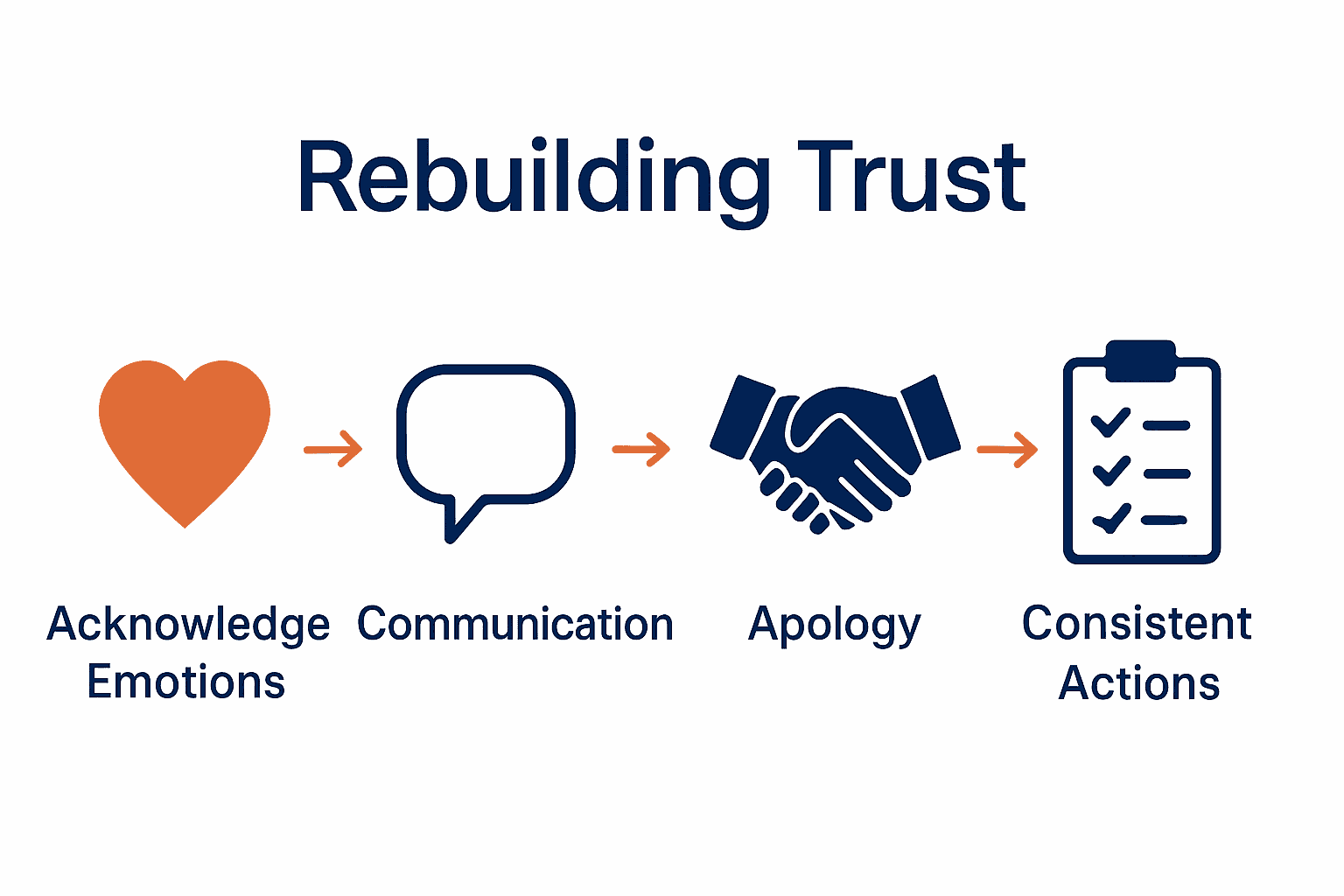Rebuilding Trust After Betrayal: A Step-by-Step Process

Nearly 70 percent of relationships struggle to recover after trust is broken. Betrayal leaves deep marks, making even simple conversations feel heavy or uncertain. If you have experienced hurt, you know that trust is fragile but not impossible to restore. Understanding each phase of recovery empowers you to honor your emotions, set meaningful boundaries, and rebuild a safer, more honest connection step by step.
Quick Summary
| Key Point | Explanation |
|---|---|
| 1. Acknowledge emotions and set boundaries | Recognizing feelings is crucial. Establish clear boundaries to ensure emotional safety and foster healing throughout the process. |
| 2. Communicate feelings using “I” statements | Express hurt feelings authentically and specifically. This reduces defensiveness and promotes understanding during discussions. |
| 3. Take full responsibility for your actions | A genuine apology involves acknowledging your wrongdoing without shifting blame. Clearly articulate the hurt you caused. |
| 4. Commit to consistent, reliable actions | Change is demonstrated through steady, practical actions rather than grand gestures. Follow through on commitments to build trust. |
| 5. Regularly monitor progress and reassess | Maintain ongoing evaluations of trust levels through regular check-ins. This helps adjust strategies and acknowledge emotional fluctuations. |
Table of Contents
- Step 1: Acknowledge The Impact And Set Boundaries
- Step 2: Communicate Hurt Feelings Safely
- Step 3: Take Responsibility And Apologize Effectively
- Step 4: Develop And Commit To Consistent Actions
- Step 5: Monitor Progress And Reassess Trust
Step 1: Acknowledge the Impact and Set Boundaries
Rebuilding trust starts with understanding and processing the emotional landscape after betrayal. In this critical first step, you’ll learn how to honor your feelings while creating a framework for healing and potential reconnection.
The journey begins by allowing yourself to fully experience the emotions triggered by the breach of trust. According to research from the University of Minnesota Extension, permitting negative feelings to emerge is vital for emotional processing. This means giving yourself permission to feel hurt, angry, sad, or confused without judgment.
Start by creating a safe space for honest communication. This involves sitting down with the person who broke your trust and having an open dialogue about the impact of their actions. Be specific about how their betrayal made you feel. For example, you might say “When you did X, I felt completely disregarded and unsafe in our relationship.”
Setting clear boundaries is equally crucial in this healing process. The Counselling Place suggests differentiating between what you need to know versus what you want to know to prevent potential re-traumatization. This means being strategic about the information you request and the details you explore.
Pro Tip: Your boundaries are not negotiable. They represent your emotional safety and self respect.
Practical boundary setting might look like establishing communication guidelines such as agreeing on transparency methods, setting check-in times, or defining what rebuilding trust looks like for both parties. This could mean weekly honest conversations, sharing passwords, or agreeing on specific actions that demonstrate commitment to change.
Remember that setting boundaries is not about punishment but about creating a foundation for potential healing and rebuilding. It requires mutual respect, vulnerability, and a genuine commitment to understanding each other.
As you move through this process, be patient with yourself. Rebuilding trust is not linear. Some days will feel more challenging than others. Read our guide on managing emotional recovery for additional support during this transformative journey.
Step 2: Communicate Hurt Feelings Safely
Communicating your emotional pain after a betrayal requires courage, vulnerability, and strategic emotional management. This step will help you express your hurt feelings in a way that promotes healing and creates space for genuine understanding.
According to Healthline, open and honest communication about the betrayal is foundational to rebuilding trust. This means creating a safe environment where you can articulate your emotional experience without fear of additional harm or dismissal.
Start by choosing the right moment and setting for your conversation. Find a quiet space where both parties feel physically and emotionally secure. Your goal is not to attack but to express your authentic feelings. Use clear, specific language that describes your emotional experience. Instead of generalizing, share concrete examples of how the betrayal impacted you.
Psychology Today emphasizes the importance of acknowledging the emotional trauma, including potential hypervigilance that might emerge after a significant breach of trust. This means being honest about your fears, anxieties, and emotional reactions.
Pro Tip: If emotions become overwhelming during the conversation, it is completely acceptable to pause and resume the discussion later.
Practical communication strategies include using first-person statements that focus on your experience. For example: “I felt deeply hurt when X happened” rather than “You always do this.” This approach reduces defensiveness and creates space for mutual understanding.
Be prepared for potential emotional responses. The person who broke your trust might feel defensive, ashamed, or uncertain. Your job is to stay focused on expressing your feelings, not managing their reaction. Learn more about controlling emotional responses during difficult conversations to maintain your emotional equilibrium.
Remember that healing is not linear. Some conversations will feel more challenging than others. The key is maintaining respectful, honest communication that prioritizes your emotional safety and potential path to rebuilding trust.
Step 3: Take Responsibility and Apologize Effectively
Rebuilding trust requires more than just saying sorry. This step is about demonstrating genuine accountability and creating a pathway for healing through a meaningful, sincere apology that shows you truly understand the pain you have caused.
According to The Counselling Place, taking full responsibility for the betrayal is essential. This means moving beyond superficial statements and diving deep into understanding the profound impact of your actions.
A genuine apology starts with complete ownership. Avoid phrases like “I am sorry if you feel hurt” which subtly shift blame. Instead, use direct language: “I am sorry for what I did. I understand how my actions hurt you and damaged our trust.” Be specific about your actions and their consequences.
Research from Times Life emphasizes the importance of acknowledging your partner’s pain without becoming defensive. This means listening actively when they express their feelings and resisting the urge to explain away your behavior.
Pro Tip: A true apology focuses on the other person’s experience, not on making yourself feel better.
Break down your apology into clear components. Acknowledge the specific action, express remorse, validate their feelings, and outline concrete steps to prevent similar harm in the future. For instance: “I betrayed your trust by X. I deeply regret causing you such pain. I understand how this has made you feel unsafe and uncertain.”
Body language matters as much as words. Maintain eye contact, show vulnerability, and demonstrate that you are fully present and committed to healing.
 Check out our comprehensive guide on apologizing effectively to refine your approach.
Check out our comprehensive guide on apologizing effectively to refine your approach.
Remember that rebuilding trust is a process. Your apology is not a magic solution but the first step in a potentially long journey of healing. Patience, consistency, and genuine effort will be your most powerful tools.
Step 4: Develop and Commit to Consistent Actions
Rebuilding trust is not about grand gestures but about steady, predictable actions that demonstrate your commitment to change. This step focuses on transforming your promises into tangible, reliable behaviors that gradually restore your partner’s confidence.
Research from the University of Minnesota Extension highlights that making a commitment to positive behavior and communicating it effectively helps rebuild trust. Small consistent actions matter more than occasional dramatic displays of remorse.
Start by creating a clear, actionable plan that addresses the specific ways you broke trust. This means identifying the exact behaviors that caused harm and developing concrete strategies to prevent their recurrence. For instance, if your betrayal involved secrecy, your consistent actions might include voluntary transparency about your communications and schedules.
Research from Medium emphasizes that proving trust happens through daily actions. Doing exactly what you say you will do becomes your primary strategy for rebuilding credibility.
Pro Tip: Consistency beats perfection. Focus on steady progress, not flawless performance.
Practical steps include creating accountability mechanisms. This might mean sharing passwords, agreeing to regular check ins, or allowing your partner access to information that previously was private. The goal is not surveillance but demonstrating your commitment to openness.
Document your progress. Keep a personal journal tracking the commitments you are making and fulfilling. This helps you stay accountable and provides tangible evidence of your transformation. Learn more about maintaining emotional accountability to support your healing journey.
Remember that rebuilding trust is a marathon, not a sprint. Your partner will be watching your actions far more closely than listening to your words. Patience, transparency, and unwavering commitment are your most powerful tools in this delicate process.
Step 5: Monitor Progress and Reassess Trust
Rebuilding trust is a dynamic journey that requires continuous reflection, open communication, and mutual understanding. This step focuses on creating a framework for ongoing assessment that allows both partners to track healing and adjust expectations realistically.
The Counselling Place highlights that healing from betrayal is a time intensive process. Recovery from significant trust breaches can take six months to two years. This means patience is not just a virtue but a necessary strategy.
Schedule regular check in conversations specifically designed to discuss your relationship’s healing trajectory. These are not blame sessions but collaborative discussions where both partners can openly share their feelings, progress, and concerns. Create a safe space where vulnerability is welcomed and honest feedback is received without defensiveness.
Psychology Today emphasizes that rebuilding trust is a continuous process involving action, accountability, and dialogue. This means viewing setbacks not as failures but as opportunities for deeper understanding and growth.
Pro Tip: Approach these conversations with curiosity, not judgment. Your goal is understanding, not winning an argument.
Consider developing a structured check in process. This might involve monthly conversations where you both rate your feelings of trust on a scale, discuss specific actions that have helped or hindered progress, and collaboratively adjust your healing strategy. Document these conversations to track your evolution.

Be prepared for emotional fluctuations. Some weeks will feel more hopeful than others. Learn strategies for managing emotional uncertainty during relationship recovery to help you navigate challenging moments.
Remember that trust rebuilding is not linear. Some days you will feel incredibly close, while other days old wounds might resurface. Commitment, compassion, and consistent communication are your most powerful tools in this delicate process of healing and reconnection.
Here’s a summary of each step for rebuilding trust:
| Step | Core Focus | Key Actions |
|---|---|---|
| Acknowledge Impact & Set Boundaries | Emotional recognition Boundary setting | Process feelings Hold open dialogue Set communication rules |
| Communicate Hurt Feelings Safely | Safe expression Strategic dialogue | Use “I” statements Choose safe settings Pause if needed |
| Take Responsibility & Apologize | Accountability Meaningful apology | Own actions Express remorse Outline prevention steps |
| Commit to Consistent Actions | Steady progress Transparency | Create action plan Maintain accountability Track progress |
| Monitor Progress & Reassess Trust | Ongoing evaluation Adjust as needed | Schedule check-ins Rate trust level Document growth |
Ready to Transform Trust Issues Into Healing?
Rebuilding trust after betrayal is one of the hardest journeys anyone can face. You are navigating emotional pain, setting critical boundaries, and searching for consistency yet progress can feel slow and lonely. If you are feeling overwhelmed by repeated cycles of hurt or have trouble translating these steps into real change, you do not have to do it alone. Mastering Conflict has specialized resources and skilled clinicians to guide you through every stage of trust recovery—whether you need couples counseling, anger management support, or individual therapy to help rebuild your sense of safety and self-worth.

Take control of your healing with support tailored to you. Our anger management strategies and personalized couples therapy empower you to communicate, set boundaries, and restore emotional safety. Schedule a session or explore more resources today at Mastering Conflict so you can start rebuilding trust and confidence now, not someday.
Frequently Asked Questions
How can I effectively acknowledge the impact of betrayal in my relationship?
Acknowledge the impact by allowing yourself to fully experience your emotions regarding the betrayal. Create a safe space for honest communication where you express how the betrayal affected you while setting specific boundaries to honor your feelings.
What are practical steps for communicating hurt feelings after a betrayal?
Communicate hurt feelings by using first-person statements like “I felt hurt when…” in a quiet, secure setting to prevent defensiveness. If emotions run high, pause the conversation and resume later, allowing for a more productive dialogue.
How do I take responsibility and apologize sincerely after causing a betrayal?
Take responsibility by fully owning your actions and clearly stating, “I am sorry for what I did and understand how it affected you.” Break down your apology into specific components, including acknowledging the action, validating their feelings, and outlining future preventive measures.
What consistent actions should I take to rebuild trust steadily?
Focus on small, predictable actions such as maintaining transparency through regular updates on your communications and schedules. Create a clear action plan addressing past behavior and track your progress to demonstrate ongoing commitment.
How should I monitor progress and reassess trust during the rebuilding process?
Monitor progress by scheduling regular check-ins to discuss feelings and trust levels openly. Use a simple scale to rate feelings of trust and document discussions to keep track of your evolution and adjust your strategies as needed.
